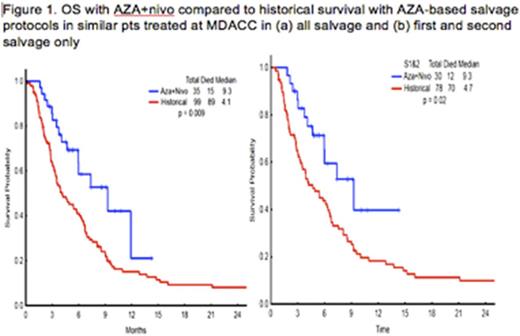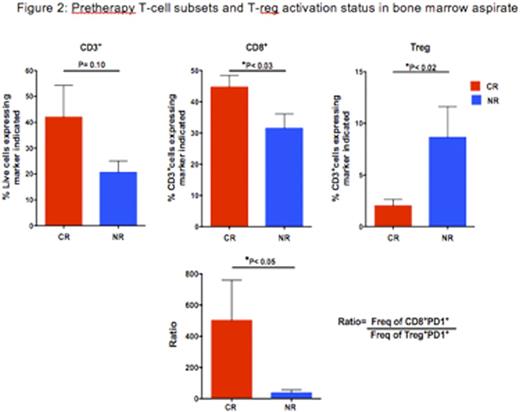Abstract
Background: Blocking PD-1/PD-L1 pathways enhances anti-leukemia responses by unleashing T-cells in murine models of AML (Zhang et al, Blood 2009). PD-1 positive CD8 T-cells are increased in bone marrow (BM) of pts with AML (Daver et al, AACR 2016). PD1 inhibition alone demonstrated limited activity in AML (Berger et al, Clin Cancer Res 2008). Rational combination strategies to enhance the anti-tumor and immunogenic effects of PD1 inhibitors in AML are needed. AZA up-regulates PD-1 and PD-L1 in AML and the up-regulation of these genes has been associated with emergence of resistance to AZA (Yang et al., Leukemia 2013).These could be blocked with the PD-1 inhibitor nivolumab.
Methods: Pts were eligible if they had AML and failed prior therapy, had adequate performance status (ECOG ² 2), and organ function. The first six pts received AZA 75mg/m2 Days 1-7 with nivolumab 3mg/kg on Day 1 and 14. Courses were repeated approximately every 4-5 weeks indefinitely. Only one of six pts had a dose limiting toxicity (grade 3 pneumonitis) and this dose was established as RP2D. 45 additional pts have been treated at the RP2D. Responses were evaluated at the end of 3 courses of therapy.
Results: 51 pts with a median age of 69 years (range, 45 - 90), secondary AML (55%), poor risk cytogenetics (47%), median number of prior regimens 2 (range, 1-7) have been enrolled. All 51 pts had baseline next generation sequencing and most frequently detected mutations included DNMT3A (n=12), TP53 (n=11), TET2 (N=9), ASXL1 (n=7), and RAS (n=7). 35 pts are evaluable for response: 6 (18%) achieved complete remission (CR)/ complete remission with insufficient recovery of counts (CRi) (3 CR, 3 CRi), 5 (15%) had hematologic improvement (HI), 9 (26%) had ³50% BM blast reduction,3 pts (9%) had stable disease > 6 months, and 12 (34%) had progression. 16 pts are early for response assessment (<3 courses). The median number of courses to CR/CRi/HI was 3 (1 - 9). The CR/CRi/HI (n=11) have been durable with no relapses among pts who achieved CR/CRi/HI [CR duration; not reached (NR)]. The 4- and 8-week mortalitywere 0 and 6%, respectively. The median overall survival for the 35 evaluable pts was 9.3 months (range, 1.8 - 14.3) (Fig 1) and this compares favorably to historical survival with AZA-based salvage protocols in similar pts treated at MDACC.
Grade 3/4 and Grade 2 immune mediated toxicities were observed in 7 (14%) and 6 (12%) pts, respectively. These included 8 episodes of pneumonitis, 2 nephritis, 2 transaminitis, and 1 skin rash. 1 pt died from grade 4 pneumonitis/epiglottitis. In the remaining 12 cases the toxicities responded rapidly to steroids and all 12 pts were successfully rechallenged with nivolumab. Time to onset of toxicities ranged from 4 days to 3.5 months. Four pts were postSCT and one had a grade 3 flare of GVHD of the skin and gut.
Multicolor flow-cytometry studies and Mass-cytometry (CyTOF) studies are conducted by the Immunotherapy Platform on baseline and on-treatment BM aspirate (end of cycle 1, 2, 4, 8) and peripheral blood to assess the T-cell repertoire and expression of co-stimulatory receptors and ligands on T cell subsets and leukemic blasts respectively. Baseline and end of cycle 1 BM was evaluated on 25 of the 35 evaluable patients, including 6 responders (CR/CRi/HI) and 19 non-responders. Pts who achieved a CR/CRi/HI had a baseline higher live total CD3 (P=0.10), CD8+ T-cells (P=0.02), and lower live CD4+Foxp3+PD1+ T-regulatory (T-reg) cells (P=0.01) infiltrate in the BM (Figure 2). The ratio of PD1+CD8+ T-effector cells to PD1+CD4+Foxp3+ T-reg cells was significantly higher in the CR/CRi/HI pts vs non-responders (208.4 vs 8.91, P<0.05) in baseline BM. On IHC evaluation OX40 appeared to increase post-treatment in non-responders but not in responders.
Conclusion: Full dose AZA and nivolumab are tolerable and produce an encouraging response rate with durable responses in relapsed AML with poor risk features. Immune mediated toxicities occur and may be adequately managed with early recognition and systemic steroids. On prelim analysis responders had higher baseline BM CD8+ T-effectors, lower T-regs and higher PD1+CD8/ PD1+CD4+Foxp3+.
Daver:Kiromic: Research Funding; Pfizer: Consultancy, Research Funding; Otsuka: Consultancy, Honoraria; Karyopharm: Honoraria, Research Funding; BMS: Research Funding; Ariad: Research Funding; Sunesis: Consultancy, Research Funding. Cortes:ARIAD: Consultancy, Research Funding; BMS: Consultancy, Research Funding; Novartis: Consultancy, Research Funding; Pfizer: Consultancy, Research Funding; Teva: Research Funding. Jabbour:ARIAD: Consultancy, Research Funding; Pfizer: Consultancy, Research Funding; Novartis: Research Funding; BMS: Consultancy. Konopleva:Reata Pharmaceuticals: Equity Ownership; Abbvie: Consultancy, Research Funding; Genentech: Consultancy, Research Funding; Stemline: Consultancy, Research Funding; Eli Lilly: Research Funding; Cellectis: Research Funding; Calithera: Research Funding.
Author notes
Asterisk with author names denotes non-ASH members.



This feature is available to Subscribers Only
Sign In or Create an Account Close Modal